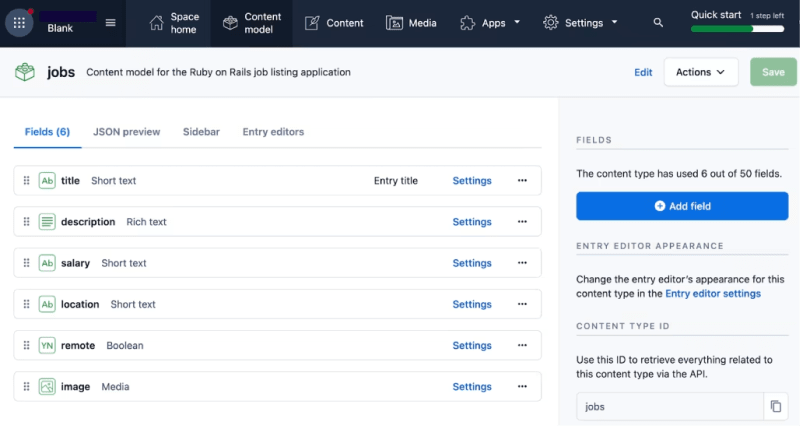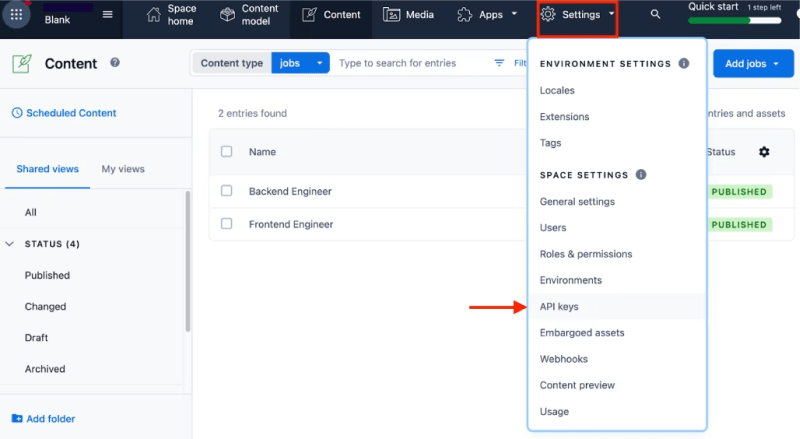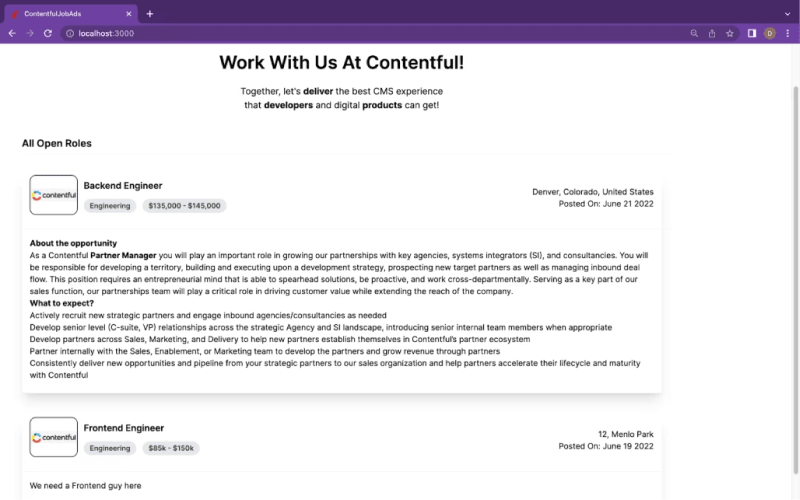NOTE: This article originally appeared on the Contentful Blog
Ruby on Rails, often shortened to Rails, is a Ruby-based Model-View-Controller (MVC) framework for building production-ready web applications and services. Rails provides several out-of-the-box features, such as database migrations and ActiveRecord (ORM), to assist developers as they build applications in minimal time.
Rails shares several similarities with Django, a Python web development framework. However, unlike Django, Rails allows developers to build the controller-specific logic of their application. They also share the convention-over-configuration philosophy and provide standard practices for developers to follow.
Developers building applications with Rails will benefit from leveraging the existing functionalities of gems created by members of the Rails community. For an improved developer experience, Contentful provides several gems that make interacting with its API easier.
To demonstrate how Contentful integrates with Rails, this article will guide you through the process of building a demo job listing application that relies on Contentful for its data. All the sample code is stored on GitHub for reference.
Prerequisites
To follow this tutorial, it’s recommended that you have:
- A Contentful account and access to Contentful UI. If you do not have one, create a free account with a free 60-day trial subscription.
- The Ruby compiler and Ruby on Rails framework installed on your computer.
- A basic familiarity with the Ruby programming language.
Preparing Contentful resources
The purpose of our job listing application is to display open job roles to job seekers. Each job listing contains several details, including the job title, description, location, and salary. To structure the data, we need to define these details on Contentful within a content model.
Using the Contentful UI, create a content model that models the fields within a job post. Each job post will be created as a data entry using this content model. For this tutorial, you will use the default Space created for every Contentful account.
Creating a Contentful content model
Once you’re logged into Contentful, click the Content Model item within the top navigation bar to navigate to the Content Editor page.
In the Create new content type model box, use “jobs” as the content model name, then provide your preferred description.
After saving the content model, use the + Add fields button to add the following fields:
- A short text field type named
titleto store the job role within the job ad, - A rich text field type named
descriptionto describe the job being posted, - A short text field type named
salaryto store a salary range for the job role, - A short text field type named
locationto store the office address, - A boolean field type named
remoteto indicate whether the job is remote, and - A media field type named
imageto store a thumbnail of the job role.
Click the Save button to save the fields you have added to the content model.
With the content model saved, the next step is to add your first entry.
Adding data into the content model
Data entries for your defined content models are managed through the Content page on Contentful. For the jobs content model, we want to add some data entries to populate the Rails application.
Navigate to the Content page and create two entries in the jobs content model. Feel free to copy job details from the Contentful career page or use your preferred details.
Retrieving Contentful API credentials
Contentful provides the Content Delivery API (CDA) for developers to retrieve data stored within a Contentful space. To access the API, provide the access token associated with your Contentful space for authentication. Tokens for a Contentful space are managed on the Settings page within the Contentful UI.
Click the Settings item within the navigation bar to reveal a dropdown, then click A*PI Keys* to view all API keys for your Contentful space.
On the next page, click the Add API Key button on the right-hand side to create the first access token for the space.
Leave all fields within the API Key at their default values and record the Space ID and Content Delivery API - access token values in a secure text editor. In the following section, you’ll use these values while building the frontend of the Ruby project.
At this point, you have created a content model and obtained your Space ID alongside the associated access token. Let’s now build the Rails application to retrieve and display the two entries within the jobs content model.
Building the Ruby on Rails application
Within this tutorial, you will use Contentful as a View Helper to retrieve entries from your Contentful Space.
To begin, execute the two commands below to ensure you have Ruby and Rails installed on your computer.
ruby --version
rails --version
If you do not have Rails installed, you could either install it following the gem command below or walk through the GoRails installation guide to install Rails for your OS:
gem install rails
Next, generate a new application using the Rails CLI with the command below. The --css flag will instruct the Rails installer to use TailwindCSS for styling the application layouts.
rails new contentful-job-ads --css tailwind
This command will create several files and folders that make up the Rails application. You will do the most work within this app directory. The File/folder section of the Rails documentation explains the purpose of each file and directory.
Move into the generated Rails project directory and use bundle to install the two gems below. You’ll use these while building the application.
- The Contentful gem for wrapping the Content Delivery and Preview APIs from Contentful. You’ll use the gem to access your content entries within Contentful from the Rails app.
- The Rich_text_renderer gem for displaying the description Rich Text within the jobs content model.
cd contentful-job-ads
bundle add contentful rich_text_renderer
Using your preferred code editor, open the contentful-job-ads project to create and modify existing files in the next section.
Defining the application route
The Rails application is intended to display a list of all available jobs on the default page immediately after the opening application. To achieve this design, change the default route within the application from the Rails welcome page to a custom page.
Open the routes.rb file within the config directory and add the path below, which matches the jobs function within the root controller.
Rails.application.routes.draw do
get '/', to: "root#jobs"
end
Next, use the Rails CLI to generate a controller named root for the path you defined above:
rails generate controller root
Creating a service object
Service objects are Plain Old Ruby Objects (PORO) created for specific functions. These are where developers keep specific business logic to avoid clogging up a controller with unrelated code.
By default, services aren’t included when you generate a Rails application. Create your first service manually with the following steps:
- Create a
servicesdirectory within thecontentful-job-ads/appfolder. - Create a
job_service.rbfile and add the code below to build theJobServiceclass.
The JobService class below contains a constructor method that instantiates the Contentful client and stores the instance in a variable. You’ll use the contentful_jobs method to retrieve all entries within the jobs content model, then use the rich_renderer method to render the rich text for the job description.
Replace the CONTENT_SPACE_ACCESS_TOKEN and CONTENTFUL_SPACE_ID placeholders with the access token and space ID credentials you previously obtained from the Contentful UI. Optionally, you can access these credentials using environment variables to ensure they’re not leaked when the application code enters a public code repository like GitHub.
class JobService
def initialize
@client ||= Contentful::Client.new(
access_token: "CONTENTFUL_SPACE_ACCESS_TOKEN",
space: "CONTENTFUL_SPACE_ID",
dynamic_entries: :auto,
raise_errors: true
)
end
def rich_renderer
@renderer = RichTextRenderer::Renderer.new
end
def contentful_jobs
@client.entries(content_type: "jobs", include: 2)
end
end
Next, open the contentful-job-ads/config/application.rb file and add the code below into the Application class to load the custom services directory.
config.eager_load_paths << Rails.root.join("app/services")
Creating application view
Create a jobs method within the root controller to instantiate the additional JobsService class. The root controller resides in the app/controllers/root_controller.rb file.
def jobs
@job_instance = JobService.new
end
Then, create a jobs.html.erb file within the app/views/root folder for the Rails application to render as its default page.
Add the code below to the jobs.html.erb file:
<!DOCTYPE html>
<html>
<head>
<title>All Jobs</title>
<meta name="viewport" content="width=device-width,initial-scale=1">
<%= csrf_meta_tags %>
<%= csp_meta_tag %>
<%= stylesheet_link_tag "tailwind", "inter-font", "data-turbo-track": "reload" %>
<%= stylesheet_link_tag "application", "data-turbo-track": "reload" %>
<%= javascript_importmap_tags %>
<% jobs = @job_instance.contentful_jobs %>
</head>
<body>
<div style="width: 80rem;" >
<nav class="flex flex-col items-center align-center" >
<div>
<p class="text-center text-4xl font-semibold" > Work With Us At Contentful! </p>
<br />
<p class="text-center text-lg" >
Together, let's <strong> deliver </strong> the best CMS experience <br /> that <strong> developers</strong> and digital <strong> products</strong> can get!
</p>
</div>
</nav>
<br />
<br />
<section>
<div class="flex flex-row justify-between" >
<div>
<h1 class="pb-2 text-xl font-semibold" > All Open Roles </h1>
</div>
</div>
<hr />
</section>
<br />
<section>
<ul>
<% jobs.each do |product| %>
<li class="mb-12 pb-2 shadow-xl rounded-lg">
<div>
<div class="m-4 flex flex-row justify-between" >
<div class="flex" >
<div class="flex items-center border-2 border-gray-600 mr-3 h-20 w-24 rounded-xl" >
<img alt="<%= product.title %>" src="https:<%= product.image.url%>" />
</div>
<div class="mt-2" >
<p class="font-semibold text-lg mb-2" >
<%= product.title %>
</p>
<div class="pt-1 pb-2">
<span class="inline-block bg-gray-200 rounded-full px-3 py-1 text-sm font-semibold text-gray-700 mr-2 mb-2">Engineering</span>
<span class="inline-block bg-gray-200 rounded-full px-3 py-1 text-sm font-semibold text-gray-700 mr-2 mb-2"><%= product.salary %></span>
</div>
</div>
</div>
<div class="flex items-center" >
<div class="text-right" >
<p > <%= product.location %></p>
<p > Posted On: <%= product.created_at.strftime("%B %d %Y") %></p>
</div>
</div>
</div>
<hr />
<div class="m-4" >
<%= @job_instance.rich_renderer.render(product.description).html_safe %>
</div>
</div>
</li>
<% end %>
</ul>
</section>
</div>
</body>
</html>
To confirm that the application is working, you will start the Rails server to view the application you have built so far.
Launch a separate terminal window and execute the watch command below to generate the TailwindCSS classes used in the jobs.html.erb file.
rails tailwindcss:watch
Next, in your existing terminal window, run the command below to start the rails server:
rails server
Note: Alternatively, you can install Foreman on your computer and execute the ./bin/dev command to simultaneously generate the TailwindCSS classes and also run the Rails server in a single terminal.
Using your web browser, navigate to the index page of the running Rails application at local:host3000. You will see the following:
Further functionality
Rails provides other features to extend the basic functionality of the job listing application that we’ve built.
One notable Rails feature is Active Record, which allows developers to design the model layer of an application. Contentful’s contentful_model gem allows you to associate your Rails models with content models.
Conclusion
Congratulations on building a job listing application that retrieves and displays job entries from a Contentful Space! To build the application, you successfully followed the Contentful as a View Helper approach by creating the Contentful client within a Service Object.
Are you interested in building a related project using Contentful? Create a free Contentful account and begin designing your content model!


























